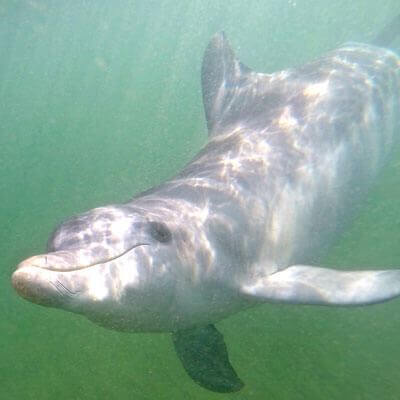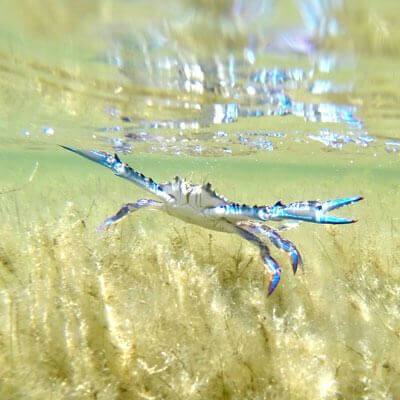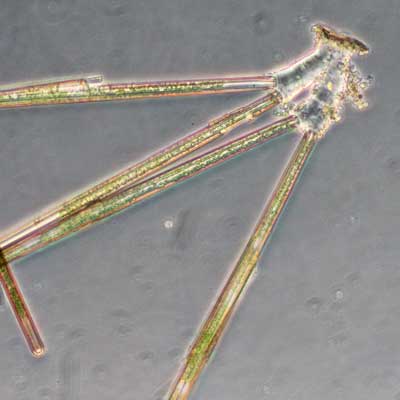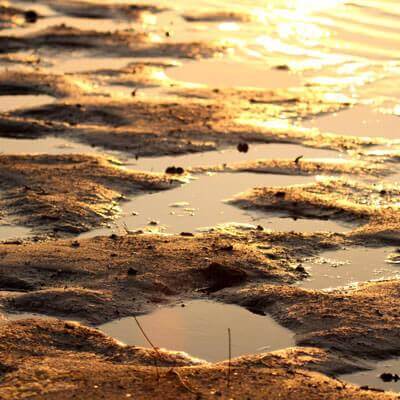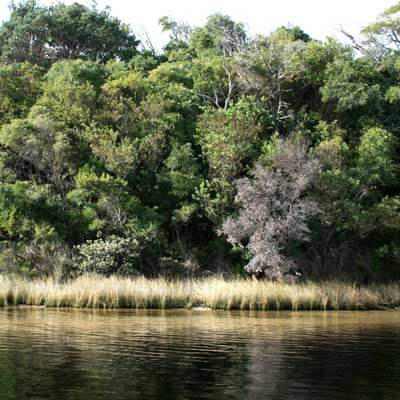Sediments
Estuaries are depositional environments where sediments and nutrients naturally accumulate. However, catchment land clearing dramatically increases the rate of sediment transport to our estuaries. While there is a large pulse of sediment associated with the initial land clearing, ongoing erosion in the catchment and within estuary primary production (driven by nutrient enrichment of the waterways) continues to increase rates of sediment accumulation. Foreshore erosion is evident in parts of the Brunswick, Preston and Collie rivers, and continues to deliver sediment to the Leschenault Estuary.
Estuary health is affected when there is an increase in organic loading that increases nutrient availability through nutrient cycling. Also, when sediment is too rich in organic matter and fine material, oxygen is depleted, and the diversity and abundance of invertebrates living in the sediment decreases. The benthic fauna is the major food source for most fish in the estuary and depends on the right flora of microscopic and larger algae, seagrasses and dead plant material or detritus. Sadly, molluscs, small crustaceans and polychaetes are showing decreases in population abundance corresponding with the decrease in seagrass cover throughout the estuary – shown by surveys in 1982 and 1997.
Since “the cut” was constructed, wave-dominated ocean processes have increased sedimentation of the lower estuary and modified the deltas to a series of channels and islands. River flow also brings sediments into the estuary. Coarser sediments are deposited around the entrance to the Collie and Preston rivers, forming tidal flats, while finer sediments are transported throughout the main basin. The Preston River delta has been modified by dredging. Bunbury Port is currently being developed and another realignment of the Preston River is planned.
Sediments can act as a nutrient sink – where nutrients are stored within the sediments, or a nutrient source to the overlaying water. Degradation of the organic matter can release soluble inorganic nutrients which are available to plants and algae such as nitrate, ammonium and phosphate, or if conditions are right, nitrogen can be converted into nitrogen gas and released into the atmosphere. The nutrient cycling processes are intrinsically liked to the oxygen condition of the water, and low oxygen conditions often associated with eutrophication, exacerbate the problems. Nutrients released from sediment under low oxygen conditions often fuel phytoplankton blooms.
Scientific studies were conducted in the main body of the Leschenault Estuary by the Department of Water and Environmental Regulation in collaboration with Geoscience Australia in 2009 to describe the characteristics of the sediments and the degree to which they act as sinks or sources for nutrients. These studies found:
- sediments across most of the estuary to be organic-rich and contain large amounts of fine-grained mud
- sediments nearer “the cut” and along shallower sections of the eastern and western shorelines were lower in organic matter content and were coarser grained
- sediment nutrient concentrations were surprisingly low, particularly given the composition of fine sediments and the high organic-matter content, and
- concluded that the sediments in the estuarine basin did not appear to act as a sink or major source of nutrients
These studies did not include the estuarine sections of the rivers where phytoplankton blooms occur most years and fish deaths are reported. These areas appear to be accumulating sediment and releasing nutrients during summer when these areas are salinity stratified and suffer from low dissolved oxygen condition.
Further studies suggest that release of phosphate from sediment is lower than expected from other estuarine systems because it is commonly bound in mineral form (apatite). The removal of nitrogen from the estuary (through a process called denitrification) is believed to play a significant role in the Leschenault Estuary. Nitrogen fixation, where nitrogen from the atmosphere is converted into ammonia, also occurs and is generally associated with seagrass habitats. It is not unusual for denitrification to occur during the day and nitrogen fixation to occur at night. Rates of denitrification suggest that almost all excess nitrogen in the upper estuary is being denitrified, that is, nitrogen is not accumulating in the sediments; whereas in the middle estuary sites, denitrification rates are lower and only 50% of the nitrogen is lost to the atmosphere.


